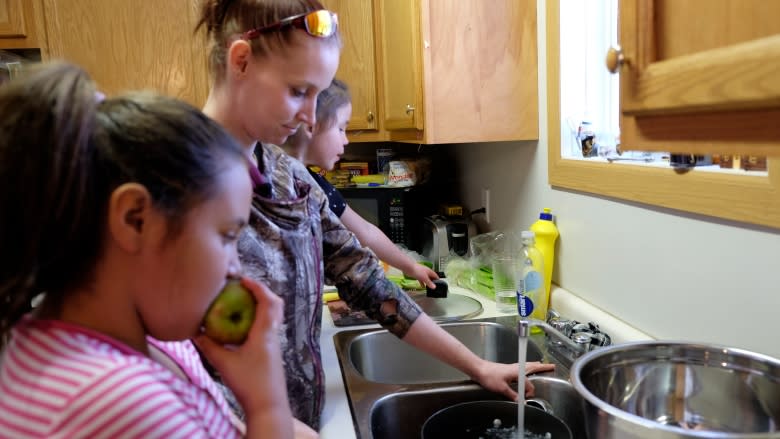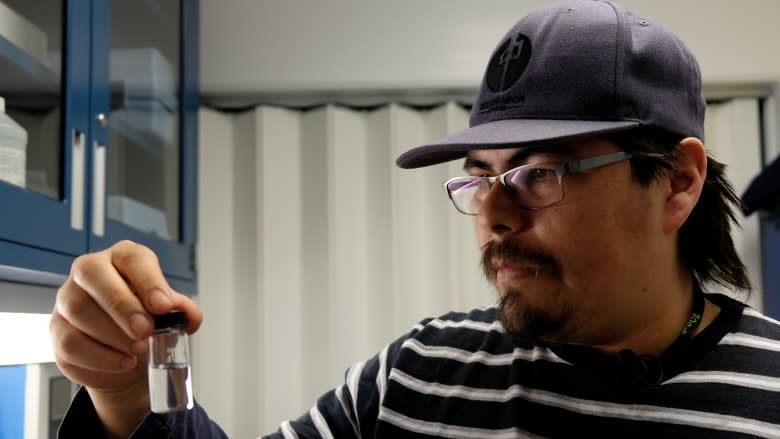'Excited over the simple things': First Nation enjoys turning on the taps after 10 years without clean water
Makayla McWatch can clearly remember the first time she drank water from a tap at home. For the 12-year-old, it only came last summer.
"My mom told me there's this fresh water we could drink. And I was like, 'What?'" she recalls. "I turned on the tap, and I had a cup, and put [water] in a cup — and it was so clear."
McWatch lives on Pic Mobert First Nation, a semi-remote community 350 kilometres northwest of Sault Ste. Marie, Ont., that was under a boil-water advisory for 10 years.
Up until last year, she had no memory of drinking water straight from the tap.
She can remember, however, what she experienced when she turned on the faucet. "It smelled like when you leave something out for a couple of days … It smells really rotten and stuff."
Pic Mobert is one of 18 Indigenous communities that got off the federal government's long-term drinking water list last year — a designation given to those that have had advisories in place for more than a year.
At the same time, 12 more communities were added to the list.
According to Indigenous and Northern Affairs Canada, a total of 71 Indigenous communities across Canada are currently unable to drink their tap water.
Prime Minister Justin Trudeau's government has promised to get all Indigenous communities off boil-water advisories by 2021, a pledge first made during the 2015 election.
Pic Mobert's situation changed thanks to a state-of-the-art water treatment plant that opened last June in the community of 350. But Chief Wayne Sabourin points out that council started the process much earlier, in 2008.
The federal government put in about $13 million and the community contributed $61,000.
"It's awesome, it's the greatest thing. You get excited over simple things that other Canadians always had," says Sabourin. "That's how we feel in the community now."
Concerns remain
Yet in spite of that excitement, Sabourin says Pic Mobert now faces new challenges.
"I don't know what it's going to cost to operate our plant," he says. "Is the federal government setting us up to fail because they're not giving us enough operation and maintenance to operate these plants?"
Unlike municipalities, which use property taxes to fund a large portion of their operating budgets, Pic Mobert has no tax base because the band owns all of the homes in the community.
"Maybe we increase the rent and take a piece of that rent," says Sabourin. "But we struggle to pay rent because we have 60 per cent unemployment."
The chief wants independence for his community, but says he feels like his hands are tied; he says increased regular federal funds will be required to keep the plant going.
Looking to the future
Pic Mobert's water treatment plant requires one full-time manager and two operators — currently trainees — to run it.
Trainee Orville McWatch Jr. grew up in Pic Mobert, and says he's proud to help his friends and family gain access to clean drinking water.
"I'm training to be a class one, and eventually, a class two operator to take care of this place," he says.
The 36-year-old says as a class one operator, he'll earn $20 an hour in Pic Mobert. But he knows if he worked in the neighbouring town, he could make $28 an hour.
"Obviously I want to stay. It's my community I want to help my community. Keep my family here, live here, grow up here, eventually maybe retire here," says McWatch. "But it's the wage that could possibly stop me from doing that."
Plant manager Dave Craig knows his trainees will struggle with wage issues. Craig has worked at several plants across northern Ontario for more than two decades.
"It's hard to find people … a lot of places in the north, it was really hard to keep operators," he says. "Turnover was amazing."
Before Pic Mobert's treatment plant was in operation, the community relied on two small pumphouses to pull and filter the water, with workers bottling and delivering around 40 to 50 large, 20-litre bottles each day.
After a decade of not trusting the taps, Craig says the transition to the new plant was initially met with some resistance.
"It was a tough go at first; a few people demanded bottled water," he says. "But we broke the news to them that we were [previously] bottling it right here and it was the same water."
Taking water for granted
Jessy Sabourin, a mother of five, says the new treatment plant has changed her life.
Before the plant opened, her family relied on the deliveries of those large water jugs for everyday use —including bathing. She recalls how she was called to the school "many times" to pick up her kids after they developed rashes. At one point, her son had impetigo.
"When [the children] were babies … we'd warm up the jug water because we didn't really trust the tap water," says Sabourin. "Now with the new water I haven't had no skin rash problems or nothing."
The majority of Canadians take their running water for granted, she says.
"Everybody thinks everyone has drinkable water, that you could just turn on a tap and it's there," she says. "That's not the reality."
Questions about timeline
In its last budget, the government committed $1.8 billion over five years to building new on-reserve water infrastructure across Canada. But a recent report questioned if the plan — and its timeline — is realistic.
Given what Pic Mobert First Nation had to go through, Chief Sabourin also has his doubts.
"To be honest, I can't see it. It's a pipe dream. I would say it would be 10 to 15, maybe 20 years before you see this all completed," he says. "That's if they're persistent and putting money toward it."
Indigenous Affairs Minister Carolyn Bennett says the federal government is committed to the five-year target.
"I don't think you get anywhere without having a hard target — and this is our hard target," she told CBC News. "We are measuring as we go. We will get there because it's so important as a commitment to equality of life."







